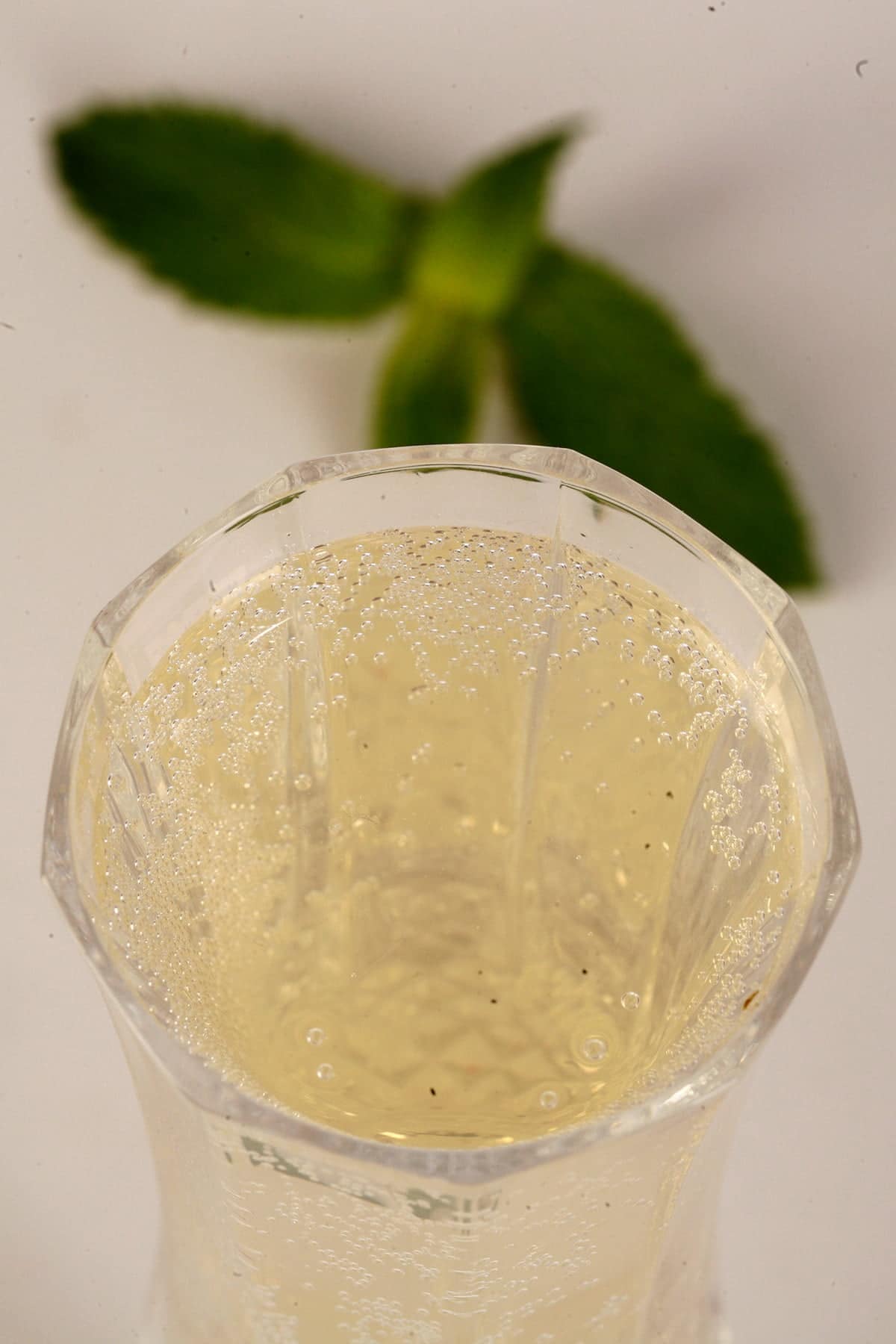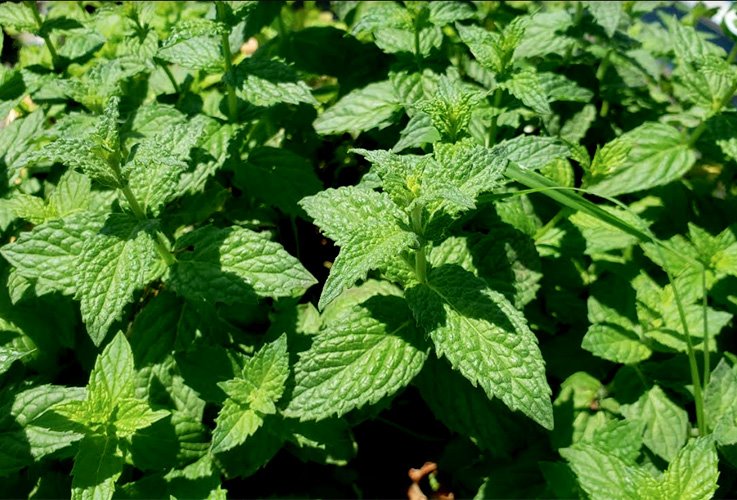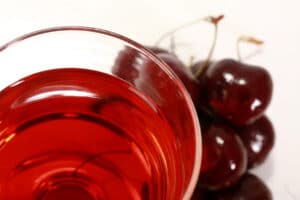Homemade Mint Wine Recipe - This is a light, sweet, unique wine.. great served chilled. If you have the patience, it's worth the wait!
Originally posted August 4, 2011. Updated 11/15/2020

The other day, I posted our recipe for Homemade Watermelon Wine..
I'm not kidding. It sounds a bit odd, and you'll question the outcome at various stages along the way.
Looking at our notes, we actually wrote "Don't bother making again" in the notes! A year after starting the wine, however, we're really glad we made it.
This wine ferments lightly and sloooowly. If you have some patience, you'll be glad you stuck it out.
This is a light, sweet, unique wine.. great served chilled. It’s a very thin bodied wine, by design. A more full bodied wine wouldn’t work so well with the flavour profile of this one, IMHO. We like this one best with a bit of carbonation.
Other than that, mint is easy to make, and SUPER cheap if you - like a lot of people I know - have a patch of mint that's bent on taking over your yard.
Homemade Mint Wine is a great summer project!

How to Make Mint Wine
If you haven't attempted making wine before, don't be intimidated! Check out our primer to home brewing:
- Wine Making At Home, Part 1: Why?
- Wine Making at Home, Part 2: Equipment to Get Started
- Wine Making at Home, Part 3: The Brewing Process.
- Wine Making at Home, Part 4: How to Stabilize and Back Sweeten Wine
Just a small handful of entries, and you'll be good to go!

Mint Wine Ingredients
Spring Water
While using tap water can be an option, we opt to use jugs of spring water, for a couple of reasons..
First of all, life in Minneapolis opened our eyes to the fact that tap water doesn’t always taste good. While our water here in Hamilton always tastes fresh and clean (without a filter even!), we know that’s not the case for everyone. Bottled spring water won’t introduce any weird, undesirable flavours to your wine.
Additionally, there’s the convenience factor. Not only is it clean tasting, it’s pre-measured, sterile, and handy.
However, if your tap water is consistently tasty and safe, feel free to use that instead of bottled.

Mint
We use fresh mint out of the garden. You can use whatever variety of mint you happen to be growing - if you like to eat it, you’ll likely enjoy the wine it makes.
Wash the mint well, pull the leaves off the stems, and pack the leaves well when measuring.
I like to crush the leaves by hand when adding it to the pot - this will release the flavours a little more.
Sugar
Type of Sugar
In terms of type of sugar, we prefer to use plain white granulated sugar for this wine. It’s a good neutral flavour, and I really think that brown sugar or maple syrup would overwhelm the mint flavour.

How to Make Mint Mead
If you’d like to make a mead rather than a wine, you can swap the sugar out for honey. We’ll usually use 4-5 lbs of honey for this.
A couple notes:
- I say “Mint Mead”, as that’s what most people would understand... but mead with herbs would technically called a “metheglin” -
So, swapping sugar out in favour of honey would give you a mint metheglin. The more you know!
- When you’re using honey instead of sugar, you’re going to want to be careful in your choice of honey. Where white sugar is fairly neutral in flavour, honey can be aggressively flavoured.
I recommend picking something lightly coloured and lightly flavoured - a clover or orange blossom honey, for instance.
Something like a wildflower or buckwheat honey is likely to completely overwhelm the flavour from the mint.

Alcohol Content
Aside from flavour, there’s the matter of alcohol content.
Your wine’s final ABV will vary wildly dependent on a couple things: how much sugar you add, and what kind of yeast you use (more on that in a bit)
Any amount of sugar will result in a higher alcohol content than making the same wine without sugar added. Sugar - both in the base wine itself, and from the added sugars - is what feeds the yeast, the yeast eats up the sugars and gives off alcohol as the byproduct of that process.
More sugar = more food = more alcohol... to a point, anyway. About that...
Yeast
The type of yeast you use will impact the alcohol content of the final product.
Yeast organisms don’t have an *unlimited* capacity to process sugar into alcohol. At some point, the environment they’re living in - the brewing wine - becomes too high in alcohol for the yeast to survive. They die off, the fermentation stops.
Different types of yeast have different tolerances for alcohol in the environment. That is, some yeast will be able to survive higher amounts of alcohol in the wine, so they’ll continue producing it longer than some other types.
Some types of yeast will bring you to something like an 8% ABV, while others will let things run wild until close to 20% ABV.
It’s good to know what you have in mind, when you choose your yeast. For this wine, we’ll usually use a white / champagne type yeast.

Back Sweetening Your Homemade Mint Wine
Sometimes - usually, even - you’ll find that the yeast went a bit too far with their smorgasbord, and you end up with a Mint wine that’s not as sweet as you’d like it.
... and that’s when you back sweeten it! You can read my How to Stabilize and Back Sweeten Wine post for information on how to back sweeten it.
How to Make Sparkling Mint Wine
As I’d mentioned earlier, mint wine is especially nice as a bubbly beverage. There are two main ways to accomplish this, both of which happen AFTER fermentation has ceased.
Note: Consult your local homebrew store for what your options are when it comes to bottling sparkling wine. As this ferments a bit in the bottle, normal wine bottles aren’t a good idea - they can explode from the extra pressure.
We’ll usually use beer bottle and caps for any sparkling wine or sparkling ciders that we make, but there are options more along the lines of champagne bottles. Selection and brands tend to vary wildly by location.
Anyway!
For Naturally Carbonated Sparkling Mint Wine
In a small pot, mix together 1 cup of water with 1 cup of sugar. Use a sanitized funnel to pour this into a sanitized large carboy.
Rack the wine over into this carboy, swirling it as you go.
Bottle the wine into appropriate bottles, following directions for whatever kind of cap/closure you will be using.
Allow wine to age at least a month or two – residual yeast will ferment the added sugar, carbonating the wine. Serve chilled.
For Force-Carbonated Sparkling Mint Wine
Alternatively, you can rack the wine (without the added sugar syrup!) into a keg and force carbonate it, if you have the set up for that - That’s what we tend to do with our ciders.
Making Larger Batches of Wine
Do you have a TON of mint to use up? Good news: you can easily scale this wine recipe up - in fact, there's a function inside the recipe card itself to do the math for you!
One note, though: You don't need to multiply the yeast, but the software doesn't know that. We will use one pouch of yeast for anything from 1-5x batches, and then 1 pouch for every 5x batches beyond that.
As a related note: The recipe software is definitely geared towards cooking, not wine making. Therefore, you can pretty much ignore all of the info it gives you: The nutritional info is calculated on everything that goes into the wine.
It does not take into account how much sugar will be fermented out, how much volume is lost to racking, the fact that the fruit pulp is removed before the final product, etc.

More Home Brewing Recipes!
While you've got your current homebrew fermenting away, why not consider putting a batch of something else on, to occupy your wait time? Here are a few of my other wine, cider, and mead recipes:
Wine Recipes
Banana Wine Recipe
Blackberry Wine Recipe
Blackcurrant Wine Recipe
Blueberry Wine Recipe
Cherry Wine Recipe
Cranberry Clementine Christmas Wine Recipe
Cranberry Wine Recipe
Faux Lingonberry Wine
Lychee Wine Recipe
Mango Strawberry Wine Recipe
Mango Wine Recipe
Lychee Wine Recipe
Partridgeberry Wine Recipe
Passionfruit Wine Recipe
Peach Wine Recipe
Stone Fruit Wine Recipe
Strawberry Wine Recipe
Ube Wine Recipe
Watermelon Wine Recipe
Mead Recipes
Black Cherry Mead Recipe
Blueberry-Clementine Mead Recipe
Blueberry Mead Recipe
Clementine Mead Recipe
Pumpkin Mead Recipe
Wildflower Mead Recipe
Cider & Miscellaneous Homebrew Recipes
Hard Apple Cider Recipe
Home Brew Hard Iced Tea Recipe
Maple Hard Apple Cider Recipe

Share the Love!
Before you drink up, be sure to take some pics of your handiwork! If you post it to Bluesky, be sure to tag us - @CelebrationGen. We're also on Pinterest, so you can save all your favourite recipes to a board!
Also, be sure to subscribe to my free monthly email newsletter, so you never miss out on any of my nonsense.
Well, the published nonsense, anyway!

Ready?
Homemade Mint Wine Recipe
Equipment
- Large pot
- 2 gallon fermenter bucket and lid
- 1 - 2 1 gallon glass carboys & stoppers
- 1 air lock and stopper
- Siphon, siphon tubing.
Ingredients
- 5 cups Fresh Mint washed and packed
- 1 gallon Water
- 3 lbs Granulated Sugar
- ¼ teaspoon Wine Tannin
- 1 teaspoon Acid Blend
- 1 teaspoon Yeast Nutrient
- 1 packet Red Star “Champagne” brewing/wine yeast
Instructions
- Place mint in a large pot, add as much water as will fit in the pot (while still allowing for mashing!). Bring to a boil, remove from heat, steep for an hour.
- Strain out mint leaves, pressing well. Reserve leaves. Add sugar to mint water, bring to a boil once again, stirring until sugar dissolves. Remove from heat, cover with sanitized pot lid.
- Once mixture has cooled to room temperature, add wine tanning, acid blend and yeast nutrient. Using a sanitized funnel, transfer cooled mixture to a sanitized 1 gallon carboy.
- If you weren’t able to get a full gallon of mint “tea” out of the first batch, cover reserved mint leaves (or fresh ones, if you have plenty to spare!) with more water, and repeat – without adding any more sugar or additives. Use fresh mint/water mixture to top up the liquid in the carboy, until it’s almost full.
- Using sanitized equipment, take a gravity reading. Keep track of the number! (This is an optional step, but will allow you to calculate your final ABV %)
- Sprinkle yeast into (fully cooled!) carboy, cover with sanitized air lock. Let sit, undisturbed, overnight.
- Within 48 hours, you should notice a little fermentation activity – bubbles in the airlock, carbonation and /or swirling in the wine must. This means you’re good to go! Put the carboy somewhere cool (not cold!), and leave it alone for a month or two.
- Using sanitized equipment, rack the clarified wine off the sediment, into a clean, freshly sanitized 1 gallon carboy. Cap with sanitized airlock, leave it alone for another 2-3 months.
- Repeat racking process every few months. By 1 year in, your wine should be very clear, and VERY tasty!
- When your wine has been racked a few times and shows NO more fermenting activity for a month or so (no bubbles in the airlock, no more sediment being produced, you can move on to bottling:
- Using sanitized equipment, take a gravity reading, then rack the wine into clean, sanitized bottles. Cork, allow to age in a dark place for a year.
- Serve chilled.
Notes
Nutrition












Milly
Amazing recipes!!!
Thank you very much. I am going to try out the Mint Wine Recipe.
Leo Augustus
On your Mint wine, though I have not as yet tried it out; I got a wee bit of an innovative idea...why not add some ginger, just a wee bit, to give a hint of ginger flavourful in the wine....
Perhaps I will try it out before our Monsoon breaks out...am residing in Mumbai.
Thanks.
Marie Porter
That would be tasty!